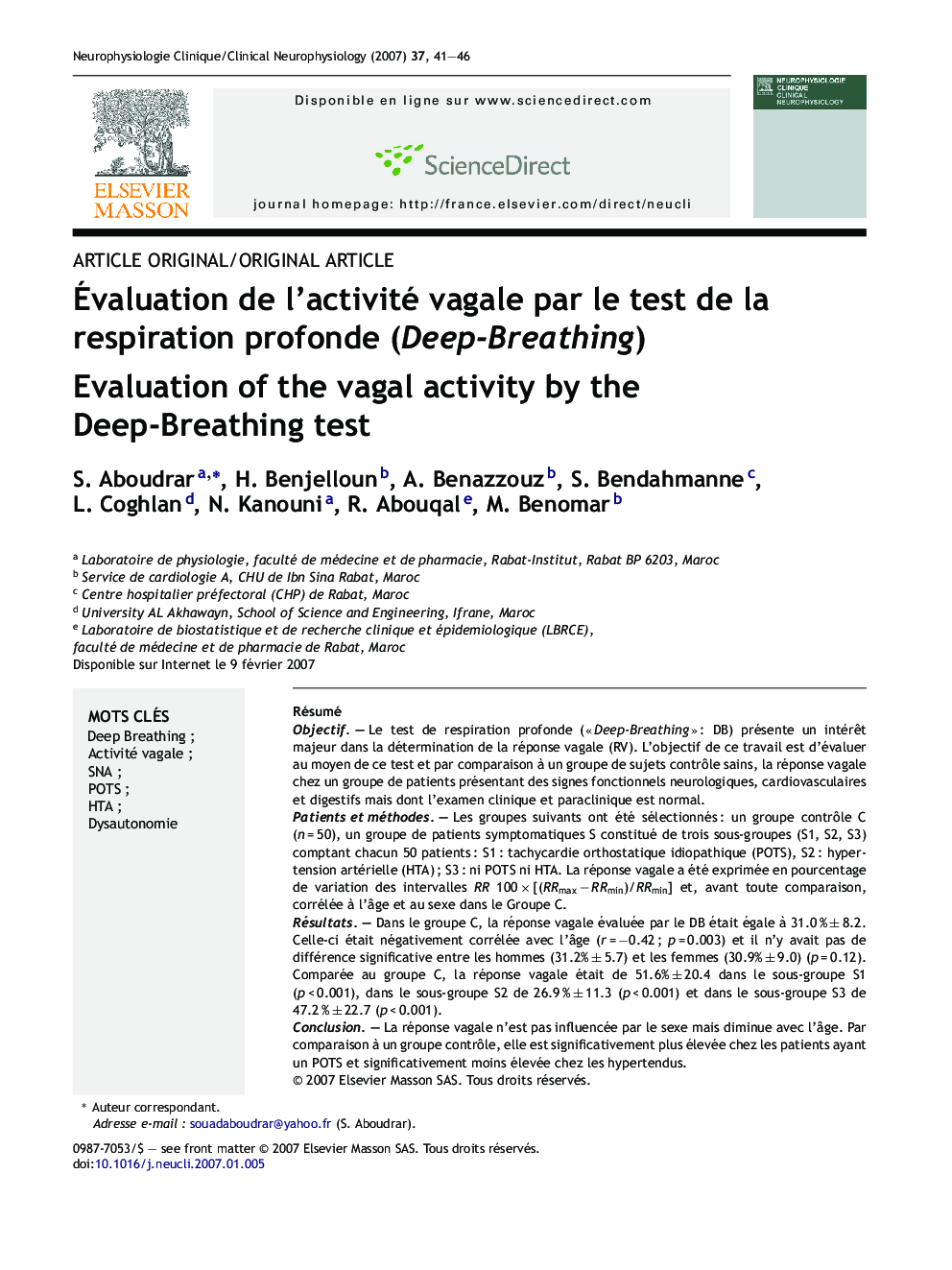| Article ID | Journal | Published Year | Pages | File Type |
|---|---|---|---|---|
| 3083078 | Neurophysiologie Clinique/Clinical Neurophysiology | 2007 | 6 Pages |
RésuméObjectifLe test de respiration profonde (« Deep-Breathing » : DB) présente un intérêt majeur dans la détermination de la réponse vagale (RV). L’objectif de ce travail est d’évaluer au moyen de ce test et par comparaison à un groupe de sujets contrôle sains, la réponse vagale chez un groupe de patients présentant des signes fonctionnels neurologiques, cardiovasculaires et digestifs mais dont l’examen clinique et paraclinique est normal.Patients et méthodesLes groupes suivants ont été sélectionnés : un groupe contrôle C (n = 50), un groupe de patients symptomatiques S constitué de trois sous-groupes (S1, S2, S3) comptant chacun 50 patients : S1 : tachycardie orthostatique idiopathique (POTS), S2 : hypertension artérielle (HTA) ; S3 : ni POTS ni HTA. La réponse vagale a été exprimée en pourcentage de variation des intervalles RR 100 × [(RRmax – RRmin)/RRmin] et, avant toute comparaison, corrélée à l’âge et au sexe dans le Groupe C.RésultatsDans le groupe C, la réponse vagale évaluée par le DB était égale à 31.0 % ± 8.2. Celle-ci était négativement corrélée avec l’âge (r = −0.42 ; p = 0.003) et il n’y avait pas de différence significative entre les hommes (31.2% ± 5.7) et les femmes (30.9% ± 9.0) (p = 0.12). Comparée au groupe C, la réponse vagale était de 51.6% ± 20.4 dans le sous-groupe S1 (p < 0.001), dans le sous-groupe S2 de 26.9 % ± 11.3 (p < 0.001) et dans le sous-groupe S3 de 47.2 % ± 22.7 (p < 0.001).ConclusionLa réponse vagale n’est pas influencée par le sexe mais diminue avec l’âge. Par comparaison à un groupe contrôle, elle est significativement plus élevée chez les patients ayant un POTS et significativement moins élevée chez les hypertendus.
ObjectiveThe Deep-Breathing (DB) test is of major importance in the evaluation of the vagal response (VR). We applied this test to assess the VR in a group of subjects with functional (neurological, cardiovascular or digestive) symptoms unexplained by standard cardiac examination and to compare it with the VR measured in a group of healthy controls.Patients and methodsThe following groups were considered: a C-Group of healthy controls (n = 50), and three groups each consisting of 50 symptomatic patients (S1, S2, S3). Subjects in the S1-Group had a postural orthostatic tachycardia syndrome (POTS), while members of the S2-Group had arterial hypertension, and members of S3-Group had neither POTS nor arterial hypertension. The VR was expressed as a percentage variation of RR intervals 100 × [(RRmax – RRmin)/RRmin], and was correlated with age and sex in the C-Group before any comparison.ResultsIn controls the VR was 31.0% ± 8.2. It was negatively correlated with age (r = −0.42, p = 0.003) and there was no significant difference between males (31.2% ± 5.7) and females (30.9% ± 9.0) (p = 0.12). Compared to the C-Group, the VR was 51.6% ± 20.4 in the S1-Group (p < 0.001), 26.9% ± 11.3 in the S2-Group (p < 0.001), and 47.2% ± 22.7 in the S3-Group (p < 0.001).ConclusionThe VR was independent of sex but was negatively correlated with age. In comparison with healthy controls, it was significantly increased in the patients with POTS and significantly decreased in hypertensives.
